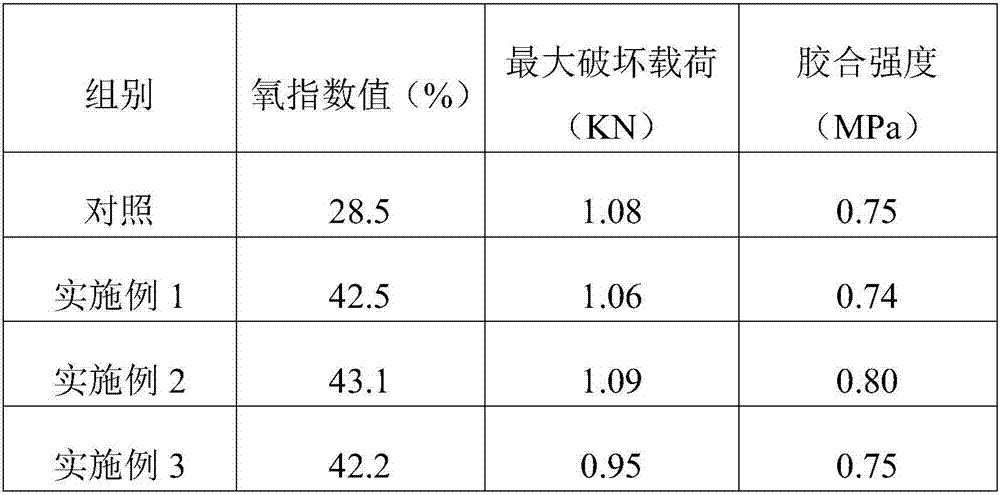Composite flame retardant for plywood and preparation method of composite flame retardant
A composite flame retardant and plywood technology, which is applied in the jointing of wooden veneers, manufacturing tools, wood treatment, etc., can solve the problems of poor loss resistance and aging resistance, great influence on the mechanical properties of plywood, and insignificant flame retardant effect, etc. problem, to achieve good flame retardant effect, smoke suppression, environmental friendliness, and good smoke suppression effect
- Summary
- Abstract
- Description
- Claims
- Application Information
AI Technical Summary
Problems solved by technology
Method used
Image
Examples
Embodiment 1
[0017] A composite flame retardant for plywood, comprising the following raw materials in parts by weight: 60 parts of polyethylene glycol, 5 parts of sodium bicarbonate, 0.1 part of polypropylene resin, 30 parts of vinyl acetate and 30 parts of boric acid; The molecular weight of polyethylene glycol is 600.
[0018] The preparation method of the composite flame retardant for plywood comprises the following steps: weighing 25 parts of polyethylene glycol, 5 parts of sodium bicarbonate, 0.1 part of polypropylene resin, 30 parts of vinyl acetate and 30 parts of boric acid, Add the pulverizer to pulverize to 120 mesh, then mix the components, and finally add water to prepare a wood composite flame retardant solution with a mass concentration of 10%.
[0019] The application of the composite flame retardant for plywood in the production of flame retardant fiberboard comprises the following production steps:
[0020] (1) Select a veneer with few knots and few defects, clean the su...
Embodiment 2
[0025] A composite flame retardant for plywood, comprising the following raw materials in parts by weight: 100 parts of polyethylene glycol, 15 parts of sodium bicarbonate, 0.5 parts of polypropylene resin, 40 parts of vinyl acetate and 40 parts of boric acid; The molecular weight of polyethylene glycol is 600.
[0026] The preparation method of the composite flame retardant for plywood comprises the following steps: weighing 35 parts of polyethylene glycol, 15 parts of sodium bicarbonate, 0.5 parts of polypropylene resin, 40 parts of vinyl acetate and 40 parts of boric acid, Add a pulverizer to pulverize to 150 mesh, then mix the components, and finally add water to prepare a wood composite flame retardant solution with a mass concentration of 15%.
[0027] The application of the composite flame retardant for plywood in the production of flame retardant fiberboard comprises the following production steps:
[0028] (1) Select a veneer with few knots and few defects, clean the...
Embodiment 3
[0033] A composite flame retardant for plywood, comprising the following raw materials in parts by weight: 80 parts of polyethylene glycol, 10 parts of sodium bicarbonate, 0.3 parts of polypropylene resin, 35 parts of vinyl acetate and 35 parts of boric acid; The molecular weight of polyethylene glycol is 600.
[0034] The preparation method of the composite flame retardant for plywood comprises the following steps: weighing 30 parts of polyethylene glycol, 10 parts of sodium bicarbonate, 0.3 parts of polypropylene resin, 35 parts of vinyl acetate and 35 parts of boric acid, Add a pulverizer to pulverize to 140 mesh, then mix the components, and finally add water to prepare a wood composite flame retardant solution with a mass concentration of 12%.
[0035] The application of the composite flame retardant for plywood in the production of flame retardant fiberboard comprises the following production steps:
[0036] (1) Select a veneer with few knots and few defects, clean the ...
PUM
 Login to View More
Login to View More Abstract
Description
Claims
Application Information
 Login to View More
Login to View More - R&D
- Intellectual Property
- Life Sciences
- Materials
- Tech Scout
- Unparalleled Data Quality
- Higher Quality Content
- 60% Fewer Hallucinations
Browse by: Latest US Patents, China's latest patents, Technical Efficacy Thesaurus, Application Domain, Technology Topic, Popular Technical Reports.
© 2025 PatSnap. All rights reserved.Legal|Privacy policy|Modern Slavery Act Transparency Statement|Sitemap|About US| Contact US: help@patsnap.com

